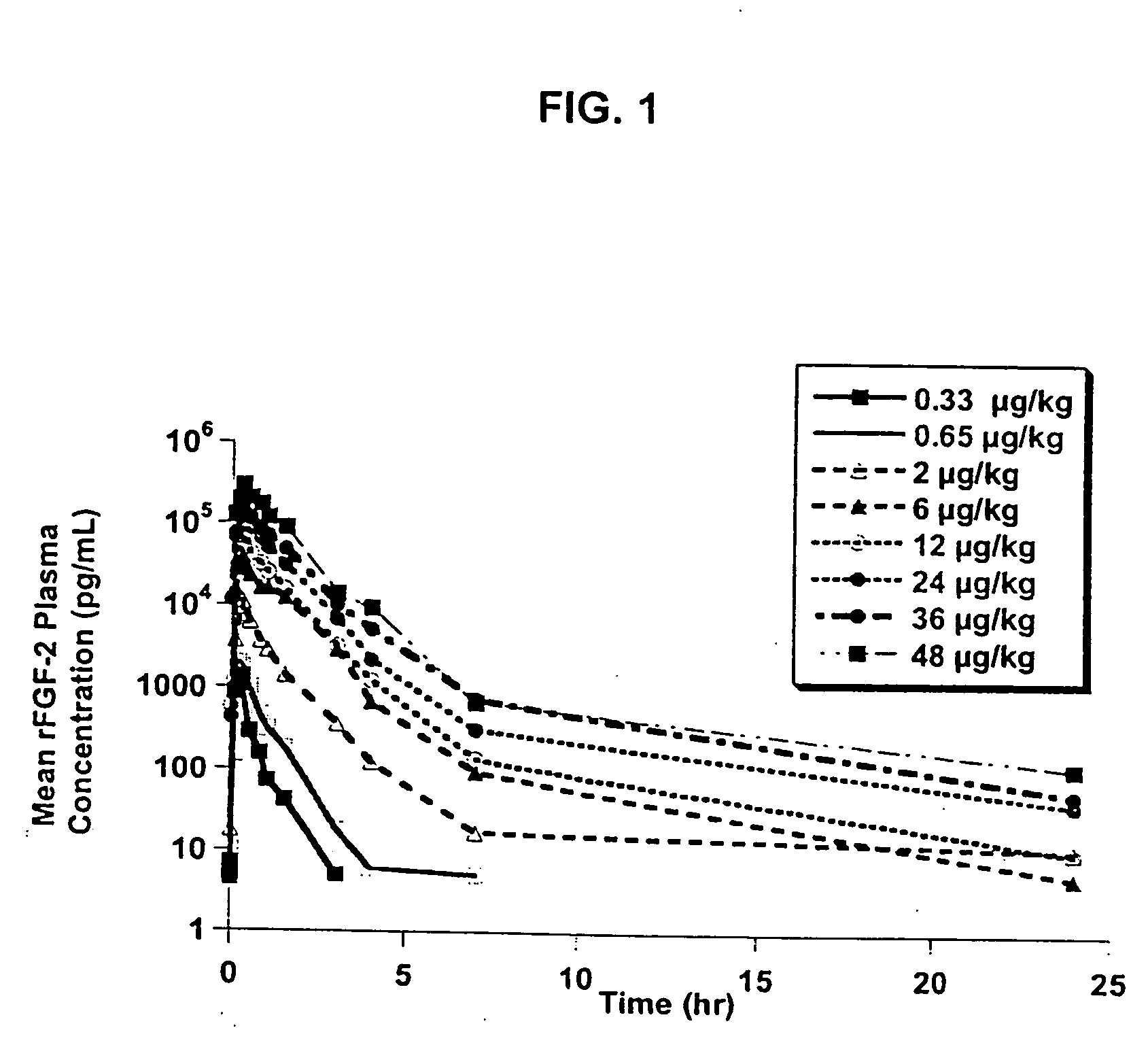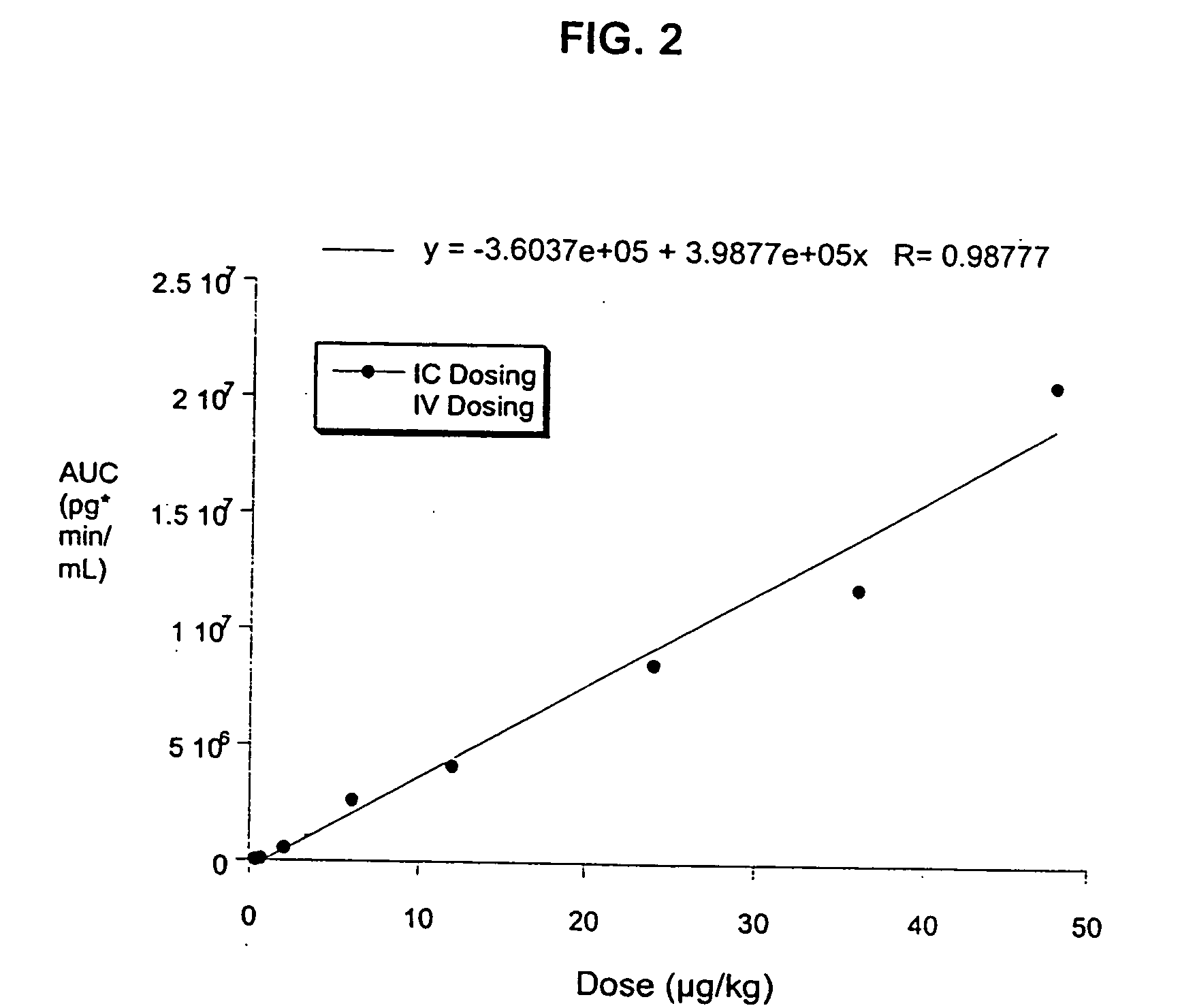Dose of an angiogenic factor and method of administering to improve myocardial blood flow
a technology of angiogenesis and angiogenesis, which is applied in the direction of angiogenin, peptide/protein ingredients, peptide sources, etc., can solve the problems of unger's method or dosage not being able to show that his method or dosage induced angiogenesis, and harada's inability to show angiogenesis, etc., to achieve the effect of reducing the wall motion score index and reducing the risk of ischemia
- Summary
- Abstract
- Description
- Claims
- Application Information
AI Technical Summary
Benefits of technology
Problems solved by technology
Method used
Image
Examples
example 1
Medium Concentration Unit Dose of rFGF-2 Employed in the Phase I Clinical Trial
[0121] The recombinant mature FGF-2 of U.S. Pat. No. 5,155,214 (Baird) was formulated as a medium concentration (0.2 μg / kg to about 36 μg / kg) unit dose and pharmaceutical composition and administered to rats, pigs and ultimately to humans in the Phase I clinical trial referenced herein. The various formulations are described below.
[0122] The Medium Concentration rFGF-2 Unit Dose was provided as a liquid in 3 cc type I glass vials with a laminated gray butyl rubber stopper and red flip-off overseal. The rFGF-2 unit dose contained 1.2 ml of 0.3 mg / ml rFGF-2 in 10 mM sodium citrate, 10 mM monothioglycerol, 1 mM disodium dihydrate EDTA (molecular weight 372.2), 135 mM sodium chloride, pH 5.0. Thus, in absolute terms, each vial (and unit dose) contained 0.36 mg rFGF-2. The vials containing the unit dose in liquid form were stored at 2° to 8° C.
[0123] The rFGF diluent was supplied in 5 cc type I glass vials ...
example 2
Selection Criteria for Patients with Coronary Artery Disease for Treatment with rFGF-2”
[0125] The following selection criteria were applied to Phase I patients with coronary artery disease, whose activities were limited by coronary ischemia despite optimal medical management, and who were not candidates for approved revascularization therapies: [0126] Inclusion criteria: Subject is eligible if: [0127] Male or female, greater than or equal to 18 years of age [0128] Diagnosis of coronary artery disease (CAD) [0129] Suboptimal candidates for approved revascularization procedures, e.g., angioplasty, stents, coronary artery bypass graft (CABG) (or refuses those interventions) [0130] Able to exercise at least three minutes using a modified Bruce protocol and limited by coronary ischemia [0131] Inducible and reversible defect of at least 20% myocardium on pharmacologically stressed thallium sestamibi scan [0132] CBC, platelets, serum chemistry within clinically acceptable range for require...
example 3
Phase I Clinical Study on Recombinant FGF-2 Administered IC to Humans
[0156] Recombinant FGF-2 of U.S. Pat. No. 5,155,214 was administered to 52 human patients with severe CAD, who remained symptomatic despite optimal medical management and who refused or were suboptimal candidates for surgical or percutaneous revascularization, in a Phase I open label, single administration, dose escalation, two-site trial. The drug was administered as a single 20 minute infusion divided between two major sources of coronary blood supply (IC), using standard techniques for positioning a catheter into the patient's coronary artery (such as already employed in angioplasty). The doses (μg / kg) of rFGF-2 administered were 0.33 (n=4), 0.65 (n=4), 2.0 (n=8), 6.0 (n=4), 12.0 (n=4), 24 (n=8), 36 (n=10) and 48 (n=10). Angina frequency and quality of life was assessed by the Seattle Angina Questionnaire (SAQ) at a baseline (before rFGF-2 administration) and at about 60 days after rFGF-2 administration. Exerci...
PUM
| Property | Measurement | Unit |
|---|---|---|
| weight | aaaaa | aaaaa |
| concentration | aaaaa | aaaaa |
| concentration | aaaaa | aaaaa |
Abstract
Description
Claims
Application Information
 Login to View More
Login to View More - R&D
- Intellectual Property
- Life Sciences
- Materials
- Tech Scout
- Unparalleled Data Quality
- Higher Quality Content
- 60% Fewer Hallucinations
Browse by: Latest US Patents, China's latest patents, Technical Efficacy Thesaurus, Application Domain, Technology Topic, Popular Technical Reports.
© 2025 PatSnap. All rights reserved.Legal|Privacy policy|Modern Slavery Act Transparency Statement|Sitemap|About US| Contact US: help@patsnap.com



